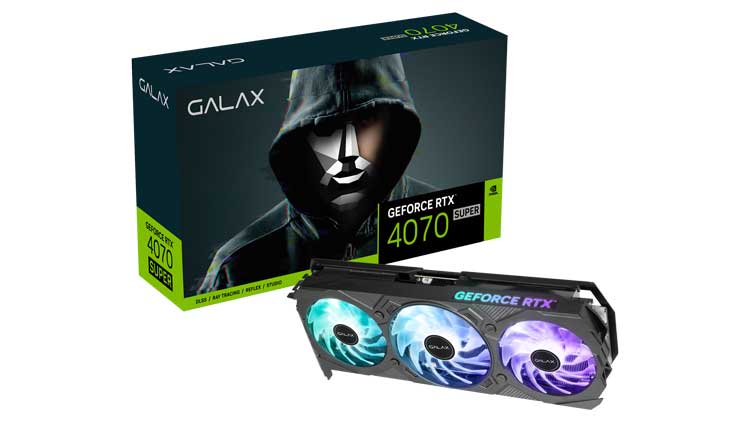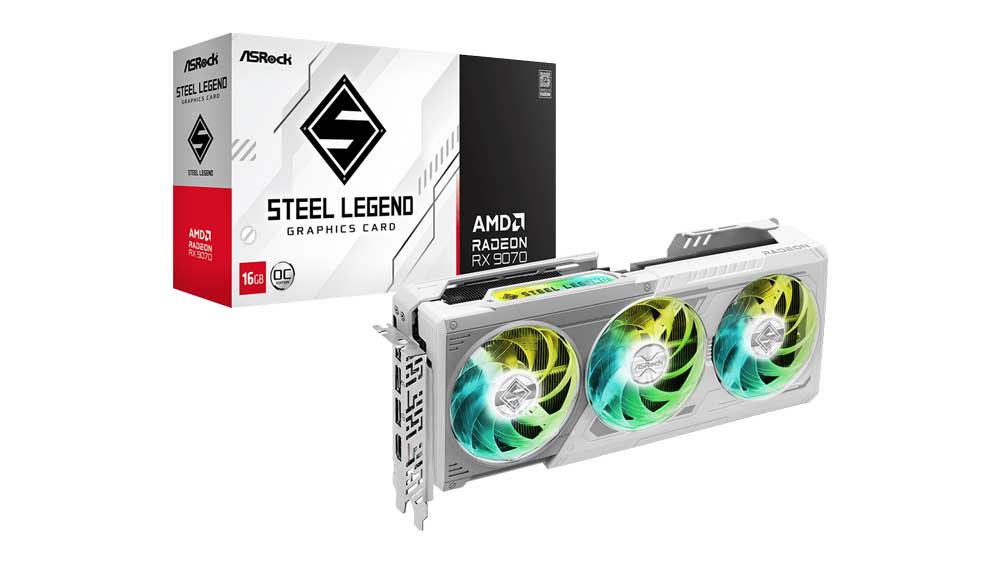The Galax GeForce RTX 4070 Super EX addresses gamers who don’t want to spend a fortune to enjoy quality HD and QHD gaming, including ray tracing. Its strong asset is DLSS 3 Frame Generation, which provides a tremendous performance boost. DLSS 3.5 is also available for even higher quality RT graphics!
During CES 2024, NVIDIA announced the GeForce RTX 40 Super Series family of GPUs, including the GeForce RTX 4080 Super, GeForce RTX 4070 Ti Super, and GeForce RTX 4070 Super. These GPUs use the latest version of the Ada Lovelace architecture. The first to come out was the RTX 4070 Super, which I received for evaluation last (but better late than never!)
The RTX 4070 Super uses the same GPU as its predecessor, the AD104. The Galax GeForce RTX 4070 Super EX that I will evaluate in this review, compared to the RTX 4070, features more cores and ROPs but has the same amount of memory running at the same speed (1313 MHz). The retail price is $600, with the plain 4070 dropping to $550. Unlike the 4070 Ti, the 4070 will remain on the market till NVIDIA releases a new GPU series.
The table below includes all major specs of the RTX 40 family, including the new and older models.
NVIDIA Graphics Cards Major Specs
| RTX 4090 | RTX 4080 Super | RTX 4070 Ti Super | RTX 4070 Super | RTX 4070 | |
|---|---|---|---|---|---|
| Architecture | AD102 | AD103 | AD103 | AD104 | AD104 |
| Process Technology | TSMC 5N | TSMC 4N | TSMC 4N | TSMC 4N | TSMC 4N |
| Base Clock (MHz) | 2235 | 2295 | 2340 | 1980 | 1920 |
| Boost Clock (MHz) | 2520 | 2550 | 2610 | 2475 | 2475 |
| VRAM Size (GB) | 24 | 16 | 16 | 12 | 12 |
| VRAM Type | GDDR6X | GDDR6X | GDDR6X | GDDR6X | GDDR6X |
| VRAM Speed (Gbps) | 21 | 23 | 21 | 21 | 21 |
| VRAM Bus Width (bit) | 384 | 256 | 256 | 192 | 192 |
| Transistors (Billions) | 76.3 | 45.9 | 45.9 | 35.8 | 35.8 |
| Shading Units | 16384 | 10240 | 8448 | 7168 | 5888 |
| TMUs | 512 | 320 | 264 | 224 | 184 |
| ROPs | 176 | 112 | 96 | 80 | 64 |
| Compute Units | 128 | 80 | 66 | 56 | 46 |
| Ray Tracing Cores | 128 | 80 | 66 | 56 | 46 |
| TDP (W) | 450 | 320 | 285 | 220 | 200 |
| Launch Month/Year | 9/22 | 1/2024 | 1/24 | 1/24 | 4/23 |
| Street Price ($) | 2000 | 1150 | 840 | 600 | 550 |
The table below contains the specs of AMD’s current-generation graphics cards for reference purposes.
AMD Graphics Cards Major Specs
| RX 7900 XTX | RX 7900 XT | RX 7900 GRE | Sapphire Radeon RX 7900 GRE | RX 7800 XT | RX 7700 XT | |
|---|---|---|---|---|---|---|
| Architecture | Navi 31 | Navi 31 | Navi 31 | Navi 31 | Navi 32 | Navi 32 |
| Process Technology | TSMC N5/N6 | TSMC N5/N6 | TSMC N5/N6 | TSMC N5/N6 | TSMC N5/N6 | TSMC N5/N6 |
| Base Clock (MHz) | 1929 | 1387 | 1880 | 1972 | 1295 | 1435 |
| Boost Clock (MHz) | 2498 | 2394 | 2245 | 2333 | 2430 | 2544 |
| VRAM Size (GB) | 24 | 20 | 16 | 16 | 16 | 12 |
| VRAM Type | GDDR6 | GDDR6 | GDDR6 | GDDR6 | GDDR6 | GDDR6 |
| VRAM Speed (Gbps) | 20 | 20 | 18 | 18 | 19.5 | 18 |
| VRAM Bus Width (bit) | 384 | 320 | 256 | 256 | 256 | 192 |
| Transistors (Billions) | 57.7 | 57.7 | 57.7 | 57.7 | 28.1 | 28.1 |
| Shading Units | 6144 | 5376 | 5120 | 5120 | 3840 | 3456 |
| TMUs | 384 | 336 | 320 | 320 | 240 | 216 |
| ROPs | 192 | 192 | 160 | 160 | 96 | 96 |
| Compute Units | 96 | 84 | 80 | 80 | 60 | 54 |
| Ray Tracing Cores | 96 | 84 | 80 | 80 | 60 | 54 |
| TDP (W) | 355 | 300 | 250 | 250 | 263 | 245 |
| Launch Month/Year | 11/22 | 11/22 | 7/23 | 2/24 | 8/23 | 8/23 |
| Street Price ($) | 930 | 750 | 550 | 570 | 500 | 420 |
- CUDA Cores: 7168
- Boost Clock: 2565MHz
- 1-Click OC Clock: 2580MHz (by installing Xtreme Tuner Plus Software and using 1-Click OC)
- Memory Speed: 21 Gbps
- Standard Memory Config: 12 GB
- Memory Interface Width 192-bit GDDR6
- Memory Bandwidth: 504 GB/sec
- PCI-E 4.0
- Fans: 2x 92mm, 1x 102mm
- Fan Stop: Yes
- Ports: 3x DisplayPort 1.4a, 1x HDMI 2.1a
- Dimensions(with Bracket): 336 * 146 * 48mm
- Dimensions(without Bracket): 323 * 131 * 48mm
- Weight: 1076g
- Warranty: two years
- MSRP (excluding VAT): $600
- Prologue & Technical specifications
- NVIDIA’s Key Technologies
- Box & Contents
- Part Analysis
- Specifications Comparison
- Test System
- Game Benchmark Details
- Raster Performance
- RT Performance
- RT Performance + DLSS/FSR Balanced
- Raytracing Performance + DLSS/FSR Balanced + FG
- DLSS/FSR Balanced (No RT)
- DLSS/FSR Balanced + FG (No RT)
- Relative Perf & Perf Per Watt (Raster)
- Relative Perf & Perf Per Watt (Raster + DLSS/FSR)
- Relative Perf & Perf Per Watt (RT)
- Relative Perf & Perf Per Watt (RT + DLSS/FSR)
- Relative Perf & Perf Per Watt (RT + DLSS/FSR + FG)
- Rendering Performance
- Operating Temperatures
- Operating Noise & Frequency Analysis
- Power Consumption
- Clock Speeds & Overclocking
- Cooling Performance
- Epilogue



Since it looks like the 40 super series uses the new 12v-2×6 headers, does this mean that ATX 3.0 psus using 12vhpwr won’t have that burning issue? Thanks for all you do.
Nope, there won’t be a problem with ATX v3.0 PSUs because the cable remains exactly the same, and on the PSU side, there weren’t any notable issues.
Thank you for the reply! I’ve been unnecessarily stressed because I got a 4080 super FE and was worried about fire thing as this is my first pc build.